
All-purpose Lightweight Individual Carrying Equipment
Encyclopedia




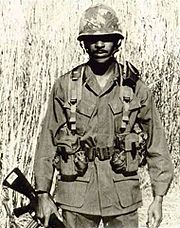

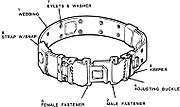

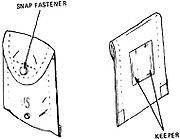

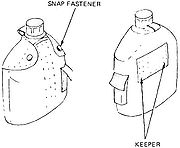
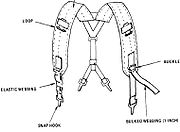
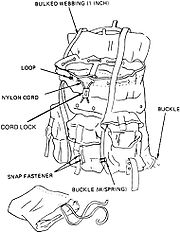
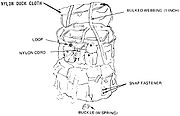


United States Army
The United States Army is the main branch of the United States Armed Forces responsible for land-based military operations. It is the largest and oldest established branch of the U.S. military, and is one of seven U.S. uniformed services...
Standard A on 17 January 1973 to replace the M-1956 Load-Carrying Equipment
M-1956 Load-Carrying Equipment
The M-1956 Load-Carrying Equipment [LCE], also known as the Individual Load-Carrying Equipment [ILCE], replaced the M-1910 olive drab cotton canvas and web individual equipment which had remained in service, with various modifications since that year...
[LCE] and M-1967 Modernized Load-Carrying Equipment
Modernized Load-Carrying Equipment
Modernized Load-Carrying Equipment, also known as M-1967 Modernized Load-Carrying Equipment or MLCE, was introduced into United States Army service in 1968 during the Vietnam War...
[MLCE]. ALICE gear is still in some limited use in the US Army in National guard and training units. USMC currently use ALICE gear in training only. Still in use by Navy and Air Force ground units.
History and development
The All-Purpose Lightweight Individual Carrying Equipment is the end result of the LINCLOE [Lightweight Individual Clothing And Equipment] program that began in 1965 and was terminated with the adoption of the ALICE system on 17 January 1973. The goal of the individual equipment portion of the LINCLOE program was to develop a lightweight load-carrying system in an effort to lighten a combat soldier's overall load.1965 - 1967
Based principally on the conclusions and recommendations of A Study To Reduce The Load Of The Infantry Combat Soldier, 1962 and A Study To Conserve Energy Of The Combat Infantryman, 1964, a Quantitative Material Requirement [QMR] was established in 1965 calling for the development of Lightweight Individual Clothing And Equipment [LINCLOE].Although the development of the LINCLOE load-carrying equipment was not officially started until after approval of the task by the United States Army Materiel Command Technical Committee
United States Army Materiel Command
The U.S. Army Materiel Command is the primary provider of materiel to the United States Army.The Command's mission includes the research & development of weapons systems as well as maintenance and parts distribution....
[AMCTC] on 27 April 1966, development of lightweight load-carrying equipment really began in 1961 with the development of the Lightweight Rucksack [FSN 8465-782-3248] made of nylon fabrics and an aluminum frame which weighed 3 pounds [1.4 kg] as compared to the 7.5 pound [3.4 kg] cotton canvas duck and steel item which it replaced.
The development of this lightweight rucksack led to an informal inquiry by officers of the infantry community as to the possibility of reducing the weight of the M-1956 Load-Carrying Equipment
M-1956 Load-Carrying Equipment
The M-1956 Load-Carrying Equipment [LCE], also known as the Individual Load-Carrying Equipment [ILCE], replaced the M-1910 olive drab cotton canvas and web individual equipment which had remained in service, with various modifications since that year...
[LCE]. As a result of this interest, a set of M-1956 Load-Carrying Equipment
M-1956 Load-Carrying Equipment
The M-1956 Load-Carrying Equipment [LCE], also known as the Individual Load-Carrying Equipment [ILCE], replaced the M-1910 olive drab cotton canvas and web individual equipment which had remained in service, with various modifications since that year...
[LCE] was made in 1962, substituting available nylon materials for the cotton canvas duck. This set of nylon load-carrying equipment weighed slightly more than 3 pounds [1.4 kg] as opposed to 5 pounds [2.3 kg] for the cotton canvas duck items. These two items, the lightweight rucksack and the set of nylon M-1956 Load-Carrying Equipment
M-1956 Load-Carrying Equipment
The M-1956 Load-Carrying Equipment [LCE], also known as the Individual Load-Carrying Equipment [ILCE], replaced the M-1910 olive drab cotton canvas and web individual equipment which had remained in service, with various modifications since that year...
[LCE], formed the basis for that portion of the LINCLOE Quantitative Material Requirement dealing with load-carrying equipment. Annex A to the Quantitative Material Requirement set a goal of 3.3 pounds [1.5 kg] for the individual load-carrying equipment and 3 pounds [1.4 kg] for the rucksack. It was decided that the design of the new load-carrying equipment would follow basically that of the standard load-carrying equipment with material changes from cotton canvas duck to nylon duck and replacement of the brass and steel hardware with aluminum or plastic items.
The design effort went slowly, due to the concentration on the design and development of items to meet the requirement of the Vietnam War
Vietnam War
The Vietnam War was a Cold War-era military conflict that occurred in Vietnam, Laos, and Cambodia from 1 November 1955 to the fall of Saigon on 30 April 1975. This war followed the First Indochina War and was fought between North Vietnam, supported by its communist allies, and the government of...
, although projects were initiated investigating the feasibility of replacing much of the steel and brass hardware with aluminum or plastic items. On 15 March 1967 an Engineering Concept Review was held at Natick Laboratories. The concept approved at the meeting was for an individual equipment belt to be supported by individual equipment suspenders, to which could be attached component items such as small arms ammunition cases, water canteen covers, entrenching tool carriers, field first aid dressing cases, etc. A field pack somewhat larger than the M-1961 cotton canvas duck field pack was proposed which could be attached for carrying either on the individual equipment belt at the small of the back, or on the shoulders attached to the individual equipment belt suspenders, or attached to a detachable field pack frame frame. The field pack frame with shoulder straps and a removable cargo shelf would be designed to be worn over the individual equipment belt and suspenders. The end result of this meeting was the adoption of the nylon M-1967 Modernized Load-Carrying Equipment
Modernized Load-Carrying Equipment
Modernized Load-Carrying Equipment, also known as M-1967 Modernized Load-Carrying Equipment or MLCE, was introduced into United States Army service in 1968 during the Vietnam War...
[MLCE]. The field pack design was rejected in the end and a nylon version of the M-1961 field pack was produced instead along with the nylon Tropical Rucksack [FSN 8465-935-6673].
1968 - 1969
Even after the adoption of the M-1967 Modernized Load-Carrying EquipmentModernized Load-Carrying Equipment
Modernized Load-Carrying Equipment, also known as M-1967 Modernized Load-Carrying Equipment or MLCE, was introduced into United States Army service in 1968 during the Vietnam War...
[MLCE] in 1967, developments continued under the LINCLOE program. The M-1967 Modernized Load-Carrying Equipment
Modernized Load-Carrying Equipment
Modernized Load-Carrying Equipment, also known as M-1967 Modernized Load-Carrying Equipment or MLCE, was introduced into United States Army service in 1968 during the Vietnam War...
[MLCE] was envisioned for use strictly in tropical environments and the development of a standard load-carrying equipment system to replace all load-carrying equipment systems continued.
During 1968 the LINCLOE program continued to refine the lightweight load-carrying system. A prototype system was designed utilizing some of the existing M-1967 Modernized Load-Carrying Equipment
Modernized Load-Carrying Equipment
Modernized Load-Carrying Equipment, also known as M-1967 Modernized Load-Carrying Equipment or MLCE, was introduced into United States Army service in 1968 during the Vietnam War...
[MLCE] components such as the water canteen cover, small arms ammunition cases, and field first aid dressing case. The individual equipment belt buckle was replaced with a plastic version of the Davis quick-release buckle and a new Vest, Combat was developed to replace the individual equipment belt suspenders. Both a small and large field pack were developed utilizing the detachable field pack frame concept scrapped in 1967.
These prototype items were presented at a Design Characteristics Review And Prototype System Review held at Natick Laboratories on 26 March 1968. It was recommended that an Engineering/Service Test [ET/ST] be carried out on this new load-carrying system design with the understanding that any design changes required be accomplished prior to testing and without another design review.
In July 1969, test items presented at the 1968 Design Characteristics Review And Prototype System Review and manufactured by the United States Army Support Center, Richmond, Virginia [under the supervision of Natick Laboratories personnel] were sent to the United States Army Infantry Board [USAIB], Fort Benning
Fort Benning
Fort Benning is a United States Army post located southeast of the city of Columbus in Muscogee and Chattahoochee counties in Georgia and Russell County, Alabama...
, Georgia; United States Army Tropical Test Center [USATTC], Fort Clayton
Fort Clayton
Fort Clayton was a United States Army base in the former Panama Canal Zone, later part of the Republic of Panama. Fort Clayton was located northwest of Balboa, Panama, with the Panama Canal located nearby. It closed in 1999 pursuant to the Torrijos-Carter Treaties...
, Panama Canal Zone; United States Army Arctic Test Center [USAATC], Fort Greely
Fort Greely
Fort Greely is a United States Army launch site for anti-ballistic missiles located approximately 100 miles southeast of Fairbanks, Alaska. It is also the home of the Cold Regions Test Center , as Fort Greely is one of the coldest areas in Alaska, and can accommodate cold, extreme cold, or...
, Alaska; and the General Equipment Test Activity [GETA], Fort Lee, Virginia. Some of the test items differed significantly from those presented at the 1968 Design Characteristics Review And Prototype System Review. The major changes were as follows:
- Belt, Individual Equipment - The individual equipment belt was changed by eliminating the center row of eyelets and replacing the single-end hook adjustments at each end with double-end hook adjustments which engaged in the two outside rows of eyelets for size adjustment.
- Vest, Combat - The closure devices utilized [originally plastic snap fasteners and hook and loop pile] on the Vest, Combat were changed as they failed during preliminary testing. They were replaced by plastic quick-release fasteners.
- Carrier, Entrenching Tool - The M-1967 nylon Entrenching tool carrier was replaced by a molded one manufactured from ethylene-vinyl acetateEthylene-vinyl acetateEthylene vinyl acetate is the copolymer of ethylene and vinyl acetate. The weight percent vinyl acetate usually varies from 10 to 40%, with the remainder being ethylene....
[EVA]. - Case, Field First Aid Dressing - Plastic belt-strap keepers were utilized on the field first aid dressing case. These replaced the standard steel M-1956 belt-strap keepers.
- Cover, Water Canteen - Plastic belt-strap keepers were utilized on the water canteen cover. These replaced the standard steel M-1956 belt-strap keepers.
Testing of this new load-carrying system, known as the LINCLOE Load-Carrying Equipment [LCE], began in July 1969 at Fort Benning
Fort Benning
Fort Benning is a United States Army post located southeast of the city of Columbus in Muscogee and Chattahoochee counties in Georgia and Russell County, Alabama...
; September 1969 at Fort Clayton
Fort Clayton
Fort Clayton was a United States Army base in the former Panama Canal Zone, later part of the Republic of Panama. Fort Clayton was located northwest of Balboa, Panama, with the Panama Canal located nearby. It closed in 1999 pursuant to the Torrijos-Carter Treaties...
; October 1969 at Fort Greely
Fort Greely
Fort Greely is a United States Army launch site for anti-ballistic missiles located approximately 100 miles southeast of Fairbanks, Alaska. It is also the home of the Cold Regions Test Center , as Fort Greely is one of the coldest areas in Alaska, and can accommodate cold, extreme cold, or...
; and November 1969 at Fort Lee.
On 19 July 1969 the Infantry Team [composed of the Commanding General, Fort Benning
Fort Benning
Fort Benning is a United States Army post located southeast of the city of Columbus in Muscogee and Chattahoochee counties in Georgia and Russell County, Alabama...
; Commanding General of the Infantry School; Commanding Officer of the Combat Developments Command Infantry Agency; and the Commanding Officer of the Infantry Board] met at Fort Benning
Fort Benning
Fort Benning is a United States Army post located southeast of the city of Columbus in Muscogee and Chattahoochee counties in Georgia and Russell County, Alabama...
to discuss improvement of infantry items of individual clothing and equipment. The LINCLOE LCE Project Officer from Natick Laboratories was invited to attend this meeting and present the status of load-carrying equipment items. The Commanding General at Fort Benning
Fort Benning
Fort Benning is a United States Army post located southeast of the city of Columbus in Muscogee and Chattahoochee counties in Georgia and Russell County, Alabama...
was unaware of the effort underway to improve the load-carrying equipment as well as other items of individual clothing and equipment. As a result of the LINCLOE LCE Project Officers attendance at this meeting, a Non-commissioned Officers [NCO] Board was established to suggest improvements to load-carrying equipment items.
The NCO Board reviewed the LINCLOE LCE under test as well as the M-1967 Modernized Load-Carrying Equipment
Modernized Load-Carrying Equipment
Modernized Load-Carrying Equipment, also known as M-1967 Modernized Load-Carrying Equipment or MLCE, was introduced into United States Army service in 1968 during the Vietnam War...
being provided to troops in Vietnam
Vietnam
Vietnam – sometimes spelled Viet Nam , officially the Socialist Republic of Vietnam – is the easternmost country on the Indochina Peninsula in Southeast Asia. It is bordered by China to the north, Laos to the northwest, Cambodia to the southwest, and the South China Sea –...
and arrived at characteristics which they considered desirable. As testing of the LINCLOE LCE continued a number of failures began to occur mostly to do with closure devices [plastic snap fasteners were still being utilized like those initially utilized on M-1967 Modernized Load-Carrying Equipment
Modernized Load-Carrying Equipment
Modernized Load-Carrying Equipment, also known as M-1967 Modernized Load-Carrying Equipment or MLCE, was introduced into United States Army service in 1968 during the Vietnam War...
items]. By December 1969 all testing had been stopped for re-evaluation of the components of the new load-carrying system.
1970 - 1971
In January 1970, the Infantry Board completed the evaluation of the load-carrying equipment, and on 17 March 1970, a conference was held at Fort BenningFort Benning
Fort Benning is a United States Army post located southeast of the city of Columbus in Muscogee and Chattahoochee counties in Georgia and Russell County, Alabama...
to review the results of the evaluation. Each item evaluated was discussed, and agreement was reached as to the changes that should be made to each load-carrying equipment item acceptable. It was also agreed that the test of the first-generation LINCLOE LCE should be stopped and new items be designed to reflect the characteristics developed as a result of the evaluations by the NCO Board and Infantry Team.
In a letter to United States Army Materiel Command
United States Army Materiel Command
The U.S. Army Materiel Command is the primary provider of materiel to the United States Army.The Command's mission includes the research & development of weapons systems as well as maintenance and parts distribution....
dated 15 April 1970, United States Army Combat Developments Command described the next generation of LINCLOE LCE for service testing based on the agreements of the 17 March 1970 meeting. The following items were recommended when modified as indicated:
- Belt, Individual Equipment - Design as furnished for evaluation with two [one upper and one lower] rows of eyelets and aluminum quick-release buckle. Also with new clinch-buckle size adjustment system.
- Suspenders, Individual Equipment Belt - M-1967 design but with single support/attachment strap in rear. The Vest, Combat was eliminated from the program due to being over-complicated and prone to failure.
- Carrier, Entrenching Tool - molded EVA version but utilizing metal snap closures [instead of plastic].
- Case, Field First Aid Dressing - Enlarged version of the M-1967 design capable of holding two field first aid dressings. Also with metal snap closures [instead of plastic].
- Case, Small Arms Ammunition - M-1967 30-round cartridge magazine design but with support strap replaced with eyelet [to attach to individual equipment belt suspenders]. Also internal divider flaps to keep cartridge magazines separated and different method of attaching hand grenades to the sides.
- Cover, Water Canteen - M-1967 design but utilizing metal snap closures [instead of plastic]. Also without pile lining and openings at the bottom to allow for drainage.
Also proposed in the letter were improved versions of the small and large field pack and field pack frame.
During April and June 1970, a prototype system of load-carrying equipment was fabricated as described in the 15 April 1970 letter. This set of load-carrying equipment was presented to the NCO Board and Infantry Team for review at Fort Benning
Fort Benning
Fort Benning is a United States Army post located southeast of the city of Columbus in Muscogee and Chattahoochee counties in Georgia and Russell County, Alabama...
on 18–19 June 1970. On 29 July 1970 representatives from the United States Army Combat Developments Command and the LINCLOE LCE Project Officer met at Natick Laboratories and drafted a revision of the LINCLOE LCE Quantitative Material Requirement as it pertained to load-carrying equipment including the characteristics for each individual item. This was based primarily on the agreements reached at the 17 March 1970 meeting. However, there was one major exception. A third field pack was added to the system by the LINCLOE LCE Project Officer. This was the medium field pack. The bag from the nylon tropical rucksack was modified to meet the NCO Board requirements for a small field pack by adapting it to be worn on the back without a field pack frame, or attached to the field pack frame.
On 5 October 1970 a Design Characteristics Review And Prototype System Review was held at Natick Laboratories concerning the new LINCLOE LCE. The Quantitative Material Requirement for the new second-generation LINCLOE LCE was approved with minor changes.
Fifteen sets of the second-generation LINCLOE LCE were fabricated in-house at Natick Laboratories and shipped to USAREUR on 17 November 1970 for evaluation. In December 1970 an additional 300 sets of the second-generation LINCLOE LCE were fabricated at the United States Army Support Center, Virginia. When completed these test sets were sent to Natick Laboratories for assembly and shipment to test sites.
In August 1971 the test sets were sent to Fort Benning
Fort Benning
Fort Benning is a United States Army post located southeast of the city of Columbus in Muscogee and Chattahoochee counties in Georgia and Russell County, Alabama...
, Fort Greely
Fort Greely
Fort Greely is a United States Army launch site for anti-ballistic missiles located approximately 100 miles southeast of Fairbanks, Alaska. It is also the home of the Cold Regions Test Center , as Fort Greely is one of the coldest areas in Alaska, and can accommodate cold, extreme cold, or...
, Fort Devens
Fort Devens
Fort Devens is an active United States military installation in the towns of Ayer and Shirley, in Middlesex County and Harvard in Worcester County in the U.S. state of Massachusetts. It was named after jurist and Civil War general Charles Devens. The nearby Devens Reserve Forces Training Area is...
, and [at their request] to the United States Marine Corps
United States Marine Corps
The United States Marine Corps is a branch of the United States Armed Forces responsible for providing power projection from the sea, using the mobility of the United States Navy to deliver combined-arms task forces rapidly. It is one of seven uniformed services of the United States...
at Quantico. During pre-test inspections a number of deficiencies were discovered with the field packs. The faulty field packs were returned to Natick Laboratories for modification. The modified items were returned to the test sites in November 1971. The service test was initiated at this time.
1972 - 1973
By March 1972, so many deficiencies and shortcomings had developed in the load-carrying equipment that the United States Army Test And Evaluation Command requested that the test at Fort BenningFort Benning
Fort Benning is a United States Army post located southeast of the city of Columbus in Muscogee and Chattahoochee counties in Georgia and Russell County, Alabama...
be suspended until test items could be repaired or replaced. A meeting was held at Fort Benning
Fort Benning
Fort Benning is a United States Army post located southeast of the city of Columbus in Muscogee and Chattahoochee counties in Georgia and Russell County, Alabama...
on 6 April 1972 to discuss the failures. As the result of the discussion, it was agreed that Natick Laboratories would take action to correct the problems in order that the tests could be resumed on 9 June 1972.
Of the deficiencies [most to do with field packs] the inner flaps on the small arms ammunition cases were asked to be removed as they impeded the rapid removal of cartridge magazines. These were replaced with simple strips of nylon fabric to divide the cartridge magazines. At some point during 1971 the United States Marine Corps
United States Marine Corps
The United States Marine Corps is a branch of the United States Armed Forces responsible for providing power projection from the sea, using the mobility of the United States Navy to deliver combined-arms task forces rapidly. It is one of seven uniformed services of the United States...
found that the small arms ammunition case with the divider flaps was acceptable and initiated acceptance procedures. On 31 January 1972 military specification MIL-C-28981(MC) was issued and these small arms ammunition cases were type classified and assigned the Federal Stock Number 8465-464-2084. The Defense Support Agency [DSA] issued contracts for the item for fiscal year 1973.
Modifications of the test items were completed in-house at Natick Laboratories, and the items were flown by military aircraft to Fort Benning
Fort Benning
Fort Benning is a United States Army post located southeast of the city of Columbus in Muscogee and Chattahoochee counties in Georgia and Russell County, Alabama...
on 1 June 1972, but the test was not reinitiated until 3 July 1972. Testing was completed on 18 August 1972 and the final report was received on 24 November 1972. As a result of the test, the Infantry Board recommended that no further development effort be expended on the load-carrying equipment as a system. On 31 October 1972, representatives from Natick Laboratories visited Fort Benning
Fort Benning
Fort Benning is a United States Army post located southeast of the city of Columbus in Muscogee and Chattahoochee counties in Georgia and Russell County, Alabama...
to discuss the problems which arose during the testing of each item and to arrive at a unified position with regard to the status of each item. Prior to these final meetings the LINCLOE LCE components had been type classified and assigned Federal Stock Numbers as follows:
- Belt, Individual Equipment - 8465-001-6487 [large], 8465-001-6488 [medium]
- Carrier, Entrenching Tool - 8465-001-6474
- Case, Field First Aid Dressing - 8465-001-6473
- Case, Small Arms Ammunition - 8465-001-6482
- Cover, Water Canteen - 8465-001-6472
- Suspenders, Individual Equipment Belt - 8465-001-6471
The three field packs were also type classified and assigned Federal Stock Numbers:
- Field Pack - 8465-001-6479 - small
- Field Pack - 8465-001-6480 - medium
- Field Pack - 8465-001-6481 - large
After the final meetings the following changes were proposed and initiated prior to manufacture:
- Belt, Individual Equipment - It was agreed to adopt the test belt, but with the standard buckle. The test item had been equipped with the Davis two-piece aluminum buckle which provided a quick-release capability.
- Suspenders, Individual Equipment Belt - It was agreed to adopt a set set of individual equipment belt suspenders similar in design to those tested, but modified so that adjustability was increased by four inches.
- Carrier, Entrenching Tool - It was agreed to adopt the EVA test item.
- Case, Field First Aid Dressing - It was agreed to reject the test item and retain the M-1967 version. The adopted characteristics required that this item to be of sufficient size to carry two field first aid dressings. It was determined that the M-1967 version, that accommodated one field first aid dressing, was acceptable.
- Case, Small Arms Ammunition - It was agreed to adopt the small arms ammunition case as tested without the internal divider flaps.
- Cover, Water Canteen - It was agreed to reject the test item; to retain the M-1967 nylon water canteen cover modified by stiffening the closing flaps so that they would not collapse and interfere with the insertion of the water canteen; to enlarge the water canteen cover somewhat for easier insertion and extraction of the water canteen cup; to add a reinforcement band to the inside of the water canteen cover to help prevent the lip of the water canteen cup from rubbing through; and add a grommet drain hole in the bottom. As requested by the NCO Board, the test cover was made without a pile liner, whose purpose was to provide evaporative cooling, and with openings in the bottom to provide better drainage and to make extraction of the water canteen cup easier. However, the test indicated that the pile liner added shape to the water canteen cover and kept it from collapsing completely when empty, making insertion of the water canteen cup much easier. It was also considered that the openings in the bottom constituted a camouflage hazard as the metal of the water canteen cup bottom was exposed.
The medium and large field packs were accepted with minor modifications but the small field pack was rejected as unnecessary. Retesting of the modified medium and large field packs were conducted at Fort Benning
Fort Benning
Fort Benning is a United States Army post located southeast of the city of Columbus in Muscogee and Chattahoochee counties in Georgia and Russell County, Alabama...
during 27 November through 18 December 1972. Based on the results it was concluded that the deficiencies and shortcomings previously reported with regard to the field packs had been corrected.
The formal Development Acceptance (DEVA) review on the LINCLOE LCE was held at Natick Laboratories on 17 January 1973. By vote of the voting members, it was agreed that the components be type classified as Standard A. After acceptance, the individual equipment system was given the designation M-1972 Lightweight Load-Carrying Equipment [LLCE]. The Defense Support Agency [DSA] began issuing contracts for the components of the new individual equipment system for fiscal year 1974 [the DSA fiscal year 1974 ran from 1 July 1973 through 30 June 1974]. After the initial contracts had been issued the individual equipment system was re-designated All-Purpose Lightweight Individual Carrying Equipment [ALICE] and the use of year-model designations officially ceased.
Current
The ALICE system has been phased out of most all active, reserve units in United States ArmyUnited States Army
The United States Army is the main branch of the United States Armed Forces responsible for land-based military operations. It is the largest and oldest established branch of the U.S. military, and is one of seven U.S. uniformed services...
. Most Basic Training units use either the standard ALICE LC-1 system or a Load Bearing Vest with canteen pouches and the belt. National Guard units use ALICE system too. ALICE was succeeded by Generation I MOLLE
Mölle
Mölle is a locality situated in Höganäs Municipality, Skåne County, Sweden with 725 inhabitants in 2005.It is best known for its scenic harbour and its location adjacent to the Kullaberg Nature Reserve...
equipment. MOLLE I was then replaced by MOLLE II which, unlike MOLLE I, is strictly for the Army's ACU instead of the BDU and DCU. The Navy and USAF use ALICE gear for ground personnel as well.
U.S. Marines use ALICE for training, deployed units use new MOLLE
Mölle
Mölle is a locality situated in Höganäs Municipality, Skåne County, Sweden with 725 inhabitants in 2005.It is best known for its scenic harbour and its location adjacent to the Kullaberg Nature Reserve...
and ILBE
ILBE
The Improved Load Bearing Equipment or ILBE is a United States Marine Corps program that includes individual load carriage equipment, individual hydration systems and individual water purification. Since the rucksack was the first part of the program issued to Marines, the ruck is commonly...
systems.
Due to the weight and discomfort associated with the pack, a common joke among users is that the pack is named ALICE so that you can call it a bitch.
Fighting and existence loads
The ALICE system retains the concept of separate fighting and existence loads that was refined in the mid-1950s during the development of the M-1956 Load-Carrying EquipmentM-1956 Load-Carrying Equipment
The M-1956 Load-Carrying Equipment [LCE], also known as the Individual Load-Carrying Equipment [ILCE], replaced the M-1910 olive drab cotton canvas and web individual equipment which had remained in service, with various modifications since that year...
[LCE]. The most important point in the fighting and existence loads concept is that an infantry rifleman should carry only the items necessary to complete the immediate mission at hand. The load an infantry rifleman carries should not include any other item that can be carried another way. Because the type of mission, terrain, and environmental conditions will influence the clothing and individual equipment requirements, the unit commander may prescribe to the infantry rifleman the essential items. The prime purpose of the fighting and existence loads concept is to lighten an infantry rifleman's load.
The typical individual fighting load is made up of essential items of clothing, individual equipment, small arms, and small arms ammunition that are carried by, and are essential to, the effectiveness of the combat infantry rifleman and the accomplishment of the immediate mission of the unit when the infantry rifleman is on foot. Normally these items are carried on the individual equipment belt and individual equipment belt suspenders.
The typical individual existence load consists of items other than those in the individual fighting load which are required to sustain or protect the infantry rifleman, which may be necessary for the infantry rifleman's increased personal and environmental protection, and which the infantry rifleman normally would not carry. When possible, the individual existence load items are transported by means other than man-carry. Otherwise both the fighting and existence loads are carried by the infantry rifleman. Individual existence load items are usually carried in the field pack.
Fighting load components
The ALICE system fighting load comprises the following components:- Belt, Individual Equipment, LC-1 [NSN 8465-00-001-6487-series]
- Carrier, Entrenching Tool, LC-1 [NSN 8465-00-001-6474]
- Case, Field First Aid Dressing, LC-1 [NSN 8465-00-935-6814]
- Case, Small Arms Ammunition, LC-1 [NSN 8465-00-001-6482]
- Cover, Water Canteen, LC-1 [NSN 8465-00-860-0256]
- Suspenders, Individual Equipment Belt, LC-1 [NSN 8465-00-001-6471]
Belt, Individual Equipment - The individual equipment belt is constructed of Army Shade 7 olive drab nylon webbing with black chemical finish adjusting buckles, keepers, and a belt buckle. The medium size individual equipment belt [NSN 8465-00-001-6488] is for soldiers with waists measuring under 30 inches [76.2 cm] and size large [NSN 8465-00-001-6487] is for those with waists measuring 30 inches [76.2 cm] or over. The individual equipment belt is adjusted from each end by means of clamp-type buckles which slide on the individual equipment belt when open. The individual equipment items are attached by interlocking belt-strap keepers or are hooked through eyelets along the bottom of the individual equipment belt. The eyelets along the top of the individual equipment belt are for attaching the individual equipment belt suspenders.
In 1981 the new Belt, Individual Equipment, LC-2 is introduced with the green plastic quick-release buckle and is assigned the National Stock Number 8465-01-120-0674 [medium] and 8465-01-120-0675 [large].
Carrier, Entrenching Tool - The Entrenching tool carrier is molded of ethylene-vinyl acetate
Ethylene-vinyl acetate
Ethylene vinyl acetate is the copolymer of ethylene and vinyl acetate. The weight percent vinyl acetate usually varies from 10 to 40%, with the remainder being ethylene....
[EVA] and the top flap is secured by means of two metal snap fasteners. It attaches to the individual equipment belt by means of two belt-strap keepers with interlocking slides. The Entrenching tool carrier is designed to accommodate the lightweight collapsible Entrenching Tool, Hand [NSN 5120-00-878-5932].
Case, Field First Aid Dressing - The field first aid dressing case is constructed of Army Shade 106 olive green water repellent treated 7.25 ounce [206 g] nylon duck. It is 8½ inches [21.6 cm] long with flap open; approximately 4½ inches [11.4 cm] wide, and forms a 4 inch [10.2 cm] deep pocket. It has a metal snap-type fastener closure and is attached to the individual equipment belt or individual equipment belt suspenders by a belt-strap keeper with interlocking slide. The field first aid dressing case is designed to accommodate either the Dressing, First Aid, Field [NSN 6510-00-159-4883] or the Compass, Magnetic, Unmounted [NSN 6605-00-151-5337].
Case, Small Arms Ammunition - The small arms ammunition case is designed to accommodate three 30-round Magazine, Cartridge [NSN 1005-00-921-5004] used with the Rifle, 5.56 Millimeter, M16A1
M16 rifle
The M16 is the United States military designation for the AR-15 rifle adapted for both semi-automatic and full-automatic fire. Colt purchased the rights to the AR-15 from ArmaLite, and currently uses that designation only for semi-automatic versions of the rifle. The M16 fires the 5.56×45mm NATO...
. It is constructed of nylon duck and webbing with polyester sheet stiffeners in the front, rear and lid of the small arms ammunition case. Each cartridge magazine is held in place by means of 3/4-inch [1.91 cm] wide webbing spacers which cross the top of the small arms ammunition case. The lid is closed by means of a plastic latch. Grenade carrying pockets are located on each side of the small arms ammunition case which are secured by means of a nylon web strap and metal snap fastener. A tab with a metal eyelet is located at the top back of the small arms ammunition case to which the individual equipment belt suspenders are attached. The small arms ammunition case is attached to the individual equipment belt by belt-strap keepers with interlocking slides.
Cover, Water Canteen - The water canteen cover is fabricated of nylon cloth and webbing and acrylic pile liner material. The two-flap closure is secured by means of metal snap fasteners. There is a small pocket on the front of the cover for carrying water purification tablets. The lid of this small pocket is secured by means of hook and pile fastener tape. The cover attaches to the individual equipment belt by means of two belt-strap keepers with interlocking slides. The water canteen cover is designed to accommodate the Canteen, Water [NSN 8465-00-889-3477]. In 1975 the LC-1 designation for the water canteen cover is changed to LC-2 due to some minor design changes. The National Stock Number remains the same.
Suspenders, Individual Equipment Belt - The individual equipment belt suspenders are Y shaped with three adjusting straps, but four points of attachment to the individual equipment belt and small arms ammunition cases. The shoulder straps are padded with spacer cloth. Each shoulder strap has a web loop and a non-slip buckle on each of the straps in the front and one at the back through which the adjusting straps pass. There are rectangular wire loops located between the web loops and the buckles on the front of the straps. The 1-inch [2.54 cm] wide adjusting straps have side-retaining snap hooks at one end. The back adjusting strap has an inverted V of which each end has a side-retaining snaphook. Each of the adjusting straps has a loop around it made of 1-inch [2.54 cm] elastic material. In 1991 the individual equipment belt suspenders are redesignated LC-2 with no apparent modifications.
Existence load components
The ALICE system existence load comprises the following components:- Cover, Field Pack [NSN 8465-00-001-6478] white
- Field Pack, LC-1 medium [NSN 8465-00-001-6480] with liners
- Field Pack, LC-1 large [NSN 8465-00-001-6481] with liners
- Frame, Field Pack, LC-1 [NSN 8465-00-001-6475] black metal
- Shelf, Cargo Support, LC-1 [NSN 8465-00-001-6476]
- Strap, Webbing, M-1967 [NSN 8465-00-001-6477] cargo strap
- Strap, Webbing, LC-1 [NSN 8465-00-269-0480] lower back strap
- Strap, Webbing, LC-1 [NSN 8465-00-269-0481] waist strap
- Strap, Webbing, LC-1 [NSN 8465-00-269-0482] left shoulder strap with quick release
- Strap, Webbing, LC-1 [NSN 8465-00-269-0483] right shoulder strap without quick release
Field Pack [medium] - The field pack is made of water repellent treated nylon duck and webbing, spacer fabric, and metal hardware. The main compartment closes by means of a drawstring secured by a plastic cord clamp. A radio pocket is located against the back on the inside. The size of the pack may be decreased for smaller loads by means of three para-cord ties, stitched to the inside bottom of the pack, and three metal D-rings located directly below the internal radio pocket. Three pockets on the outside, with strap and buckle adjustable closures and with snap fasteners for quick access, are provided for miscellaneous items. The top flap has a pocket with a hook and pile fastener tape sealed closure. Equipment hangers are located above each outside pocket and on each side. Drainage eyelets are provided in the bottom of the main compartment and the outside pockets. An envelope pocket is located at the top, back of the pack and padded with spacer cloth, into which the field pack frame is inserted when the field pack is used on the field pack frame. Buckles and straps at each side near the bottom are used for anchoring the field pack to the field pack frame. Two rectangular wire loops located at the top back of the field pack and D rings on each side at the bottom of the field pack are used to provide shoulder strap attachment when the field pack is carried without the field pack frame. A waterproof bag is supplied for the main compartment and each of the three outside pockets for keeping equipment dry.
Field Pack [large] - The construction and materials in the large field pack are similar to the medium field pack with the differences being: it is much larger in size; the center outside pocket is larger than the other two main outside pockets; and the addition of three small outside pockets above the larger pockets.
Frame, Field Pack - The field pack frame is used as a mount for either the medium field pack or the large field pack. The frame, when requisitioned, comes with all straps. The frame is of aluminum construction.
Shelf, Cargo Support - The cargo support shelf is used to support bulky loads such as water, gasoline, and ammunition cans, field rations, and radios. The shelf is of aluminum construction.
In 1977 the following existence load equipment items are introduced as replacements after modifications due to defects in the original equipment's design:
- Field Pack, LC-1 medium [NSN 8465-01-019-9102] with new buckles and no liners
- Field Pack, LC-1 large [NSN 8465-01-019-9103] with new buckles and no liners
- Frame, Field Pack [NSN 8465-01-073-8326] green metal
- Strap, Webbing, LC-2 [NSN 8465-01-075-8164] lower back strap and waist strap
- Strap, Webbing, LC-2 [NSN 8465-01-151-2891] frame attaching strap
- Strap, Webbing, LC-1 [NSN 8465-01-078-9282] right shoulder strap with quick release
See also
- M-1956 Load-Carrying Equipment
- M-1967 Modernized Load-Carrying EquipmentModernized Load-Carrying EquipmentModernized Load-Carrying Equipment, also known as M-1967 Modernized Load-Carrying Equipment or MLCE, was introduced into United States Army service in 1968 during the Vietnam War...
or MLCE - Individual Integrated Fighting SystemIndividual Integrated Fighting SystemThe Individual Integrated Fighting System or IIFS was introduced in 1988 as a possible replacement for the All-Purpose Lightweight Individual Carrying Equipment in United States armed forces service. The IIFS replaces the age-old concept of a shoulder-harness suspenders and individual equipment...
or IIFS - Modular Lightweight Load-Carrying EquipmentMOLLE (military)MOLLE |female name]]) is an acronym for MOdular Lightweight Load-carrying Equipment. It is used to define the current generation of load-bearing equipment and rucksacks utilized by the United States armed forces, especially the United States Army, and its use is also growing in the British Army in...
or MOLLE - Correaje TempexCorreaje TempexThe Correaje Tempex was a webbing equipment used by the Argentine military at the end of the Junta era and in the Falklands War replacing the "outdated" but durable green leather webbing used at the time....
used by the Argentine Army - Improved Load Bearing Equipment (ILBE) now being issued to USMC

